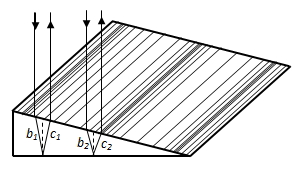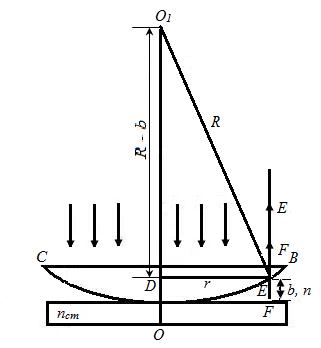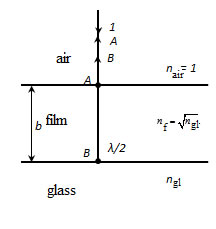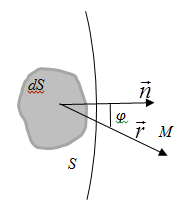main
To the list of lectures
|
2. Fringes of constant thickness. Assume that the plate thickness is not constant (~ b, n = const). Then in all the places of the plate, where the thickness b, and, hence, the path difference Δ are the same, there is one and the same result of the interference. This means that along some dark or light interference fringe formed on the surface, the thickness of the plates is the same.
3. Newton's rings.
Find the radius of Newton's rings r. The optical path difference between the rays reflected from the top and bottom of the gap is
λ/2 accounts for the phase shift on π by reflection from an optically denser medium in point F. From the triangle О1DЕ follows
Then
radius of Newton's rings for the reflected light..
radius of Newton's rings for transmitted light. 4. Coated optics. The possibility of reducing the reflected light from the interference in thin films are widely used in modern optical devices (cameras, binoculars, periscopes, etc.). To do this on the front surface of the available lenses and prisms are applied in a thin transparent film, the absolute refractive index nf less nlens. The film thickness is chosen in such a way that carried out the interference minimum reflection for light with λ = 5.5 • 10-7 m, corresponding to the maximum sensitivity of the human eye (green). Such optics called coated. In reflected light, coated lenses appear colored in purple, as they are noticeably reflect only red and blue-violet light.The most complete mutual extinction of the light waves reflected from the top and bottom surfaces of the coated film on the lens, is the case of equality of the intensities of these waves, ie, with approximate equality reflection coefficients. When i1 = 0
Therefore, the optimal value nf
The minimum thickness of the film is from the condition Δ:
bmin при k = 0
The diffraction of light.
A
more detailed observation shows that the light waves come into the
geometric shadow, and the border between areas of light and shadow
appear alternating high and low light, indicating some redistribution
of light energy at this boundary. This rounding light waves borders
opaque bodies to form an interference energy redistribution on
different areas called diffraction waves. (Or, a phenomenon that occurs
when light in a medium with sharp irregularities, called diffraction of
light.) Diffraction
phenomenon can be explained by using the Huygens principle: each point
of the space to which comes a wave motion (ie, the wave front) is a
source of secondary waves, the envelope which gives the position of the
wave front in the next moment a) Huygens' principle, b) the sources of secondary waves are coherent, c) dA amplitude oscillations excited at p. M secondary sources proportional to the ratio of the area dS of the wave surface area S to the distance r from it to point M, and depends on the angle α between the external normal to the wave surface and the direction of the element dS at M.
K(φ) - proportionality factor depending on the angle φ. The resulting field in point M is a superposition of waves (1), taken for the entire wave surface:
(2) -analytical account of the principle of Huygens - Fresnel. |











